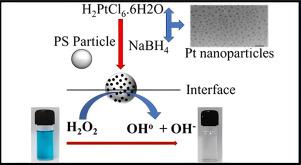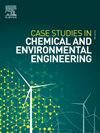使用镀铂聚苯乙烯粗颗粒增强亚甲基蓝降解的界面工程方法:流动调节催化活性和动力学建模
Q1 Environmental Science
Case Studies in Chemical and Environmental Engineering
Pub Date : 2025-09-12
DOI:10.1016/j.cscee.2025.101279
引用次数: 0
摘要
本研究探索了一种有效的净化策略,利用镀铂聚苯乙烯粗颗粒作为微米级催化剂系统来分解亚甲基蓝(MB),这是一种常见的有机污染物。采用纳米颗粒跟踪分析(NTA)、动态光散射(DLS)、原子力显微镜(AFM)、扫描电子显微镜(SEM)和透射电子显微镜(TEM)对合成的纳米材料进行了综合表征,确定了其形貌、尺寸分布和表面性质。通过界面捕获方法在空气-水界面进行净化,在控制流动环境下实现了增强的混合。实验以50 RPM的循环速度进行,对应的雷诺数(NRe)为1686,高颗粒堆积分数为0.8。在这些操作条件下,MB的完全降解在30分钟内实现,明显快于主体阶段降解所需的75分钟。分析了反应动力学,发现反应遵循Langmuir-Hinshelwood模型,估计速率常数为0.018 min−1,表明有效的表面催化活性。建立了人工神经网络(ANN)模型对降解动力学进行了验证和预测,结果表明,预测模型的均方根误差(RMSE)为5.5,相关系数(R2)为0.9656,验证了预测模型的可靠性。这种界面辅助的、基于催化剂的降解方法展示了一种有前途的、可重复使用的、具有成本效益的、环保的高级废水处理应用解决方案。本文章由计算机程序翻译,如有差异,请以英文原文为准。

Interfacial engineering approach for enhanced degradation of methylene blue using platinum-coated polystyrene rough particles: Flow-regulated catalytic activity and kinetic modeling
This study explores an efficient decontamination strategy using platinum-coated polystyrene rough-particles as a micron-sized catalyst system for decomposing methylene blue (MB), a common organic pollutant. The synthesized nanomaterials were comprehensively characterized using Nanoparticle Tracking Analysis (NTA), Dynamic Light Scattering (DLS), Atomic Force Microscopy (AFM), Scanning Electron Microscopy (SEM), and Transmission Electron Microscopy (TEM), confirming their morphology, size distribution, and surface properties. The decontamination was performed at the air-water interface through an interface trapping method, with enhanced mixing achieved under a controlled flow environment. The experiments were conducted with a circulation speed of 50 RPM, corresponding to a Reynolds number (NR) of 1686 and a high particle packing fraction of 0.8. Under these operating conditions, complete degradation of MB was achieved within 30 min, significantly faster than the 75 min required for degradation in the bulk phase. The reaction kinetics were analyzed and found to follow the Langmuir–Hinshelwood model, with an estimated rate constant of 0.018 min−1, indicating efficient surface-mediated catalytic activity. Furthermore, an Artificial Neural Network (ANN) model was developed to validate and predict the degradation kinetics, showing a Root Mean Square Error (RMSE) of 5.5 and a high correlation coefficient (R2) of 0.9656, confirming the reliability of the predictive model. This interface-assisted, catalyst-based degradation approach demonstrates a promising, reusable, cost-effective, and environmentally friendly solution for advanced wastewater treatment applications.
求助全文
通过发布文献求助,成功后即可免费获取论文全文。
去求助
来源期刊

Case Studies in Chemical and Environmental Engineering
Engineering-Engineering (miscellaneous)
CiteScore
9.20
自引率
0.00%
发文量
103
审稿时长
40 days
 求助内容:
求助内容: 应助结果提醒方式:
应助结果提醒方式:


